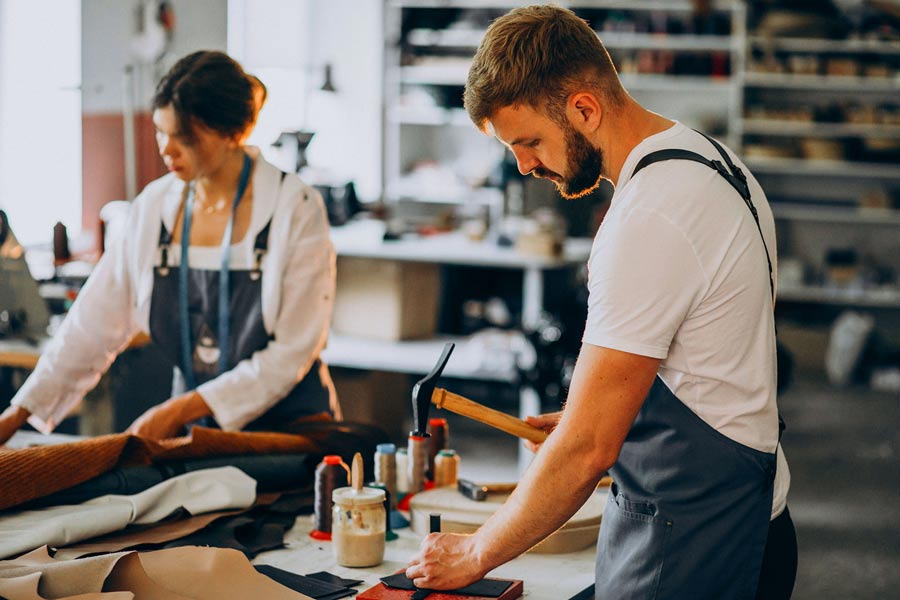
06 Jun How Is Leather Working Evolving in the 21st Century? Exploring Modern Techniques and Trends
Leather crafting has long been celebrated for its blend of beauty and durability, transcending time with its evergreen appeal. In the 21st century, this age-old craft is undergoing a profound transformation, with modern innovations reshaping it in ways our ancestors couldn’t have imagined. This post delves into how cutting-edge techniques and evolving trends are revolutionizing the leather working industry today.
Fusion of Tradition and Technology
In leather working, the old is blending seamlessly with the new. Artisans continue to honor traditional craftsmanship while embracing technological advancements that enhance precision and efficiency. Digital tools like CAD (Computer-Aided Design) software have revolutionized pattern making, allowing for intricate designs that were once impossible. Moreover, laser cutting machines bring these designs to life with impeccable accuracy and speed, marrying the artisanal with the industrial in a dance of modern efficiency.
Sustainable Practices in Leather Working
Sustainability is no longer a buzzword but a crucial pillar in the leather industry. As environmental awareness grows, so does the shift towards more sustainable practices. Innovations such as chrome-free tanning processes and the use of vegetable tannins are becoming more prevalent. Recycled leather materials and ethical sourcing are also gaining traction, reflecting a commitment to environmental stewardship without compromising the quality and luxury that leather is known for.
Innovative Design and Functionality
Today’s leather goods are not just about aesthetics; they also embrace functionality that meets modern needs. Designers are incorporating minimalist designs that reflect contemporary tastes while integrating features like RFID-blocking technology in wallets and bags with built-in charging ports. These functional enhancements cater to the tech-savvy and security-conscious consumer, proving that leather goods can be both stylish and smart.
Collaborations and Cross-Industry Influences
Leather working is increasingly crossing paths with fashion, automotive, and even tech industries, leading to fascinating collaborations that push creative boundaries. These partnerships are not only redefining how leather is used but also introducing it to new audiences. From luxury car interiors to high-fashion runways, leather’s versatility is being showcased in innovative ways that blur the lines between traditional craft and contemporary art.
Adaptation to Changing Consumer Preferences
As consumer preferences evolve, so does the approach to leather crafting. There is a growing demand for customization and personalization, with consumers wanting to imprint a part of themselves on the products they own. Direct-to-consumer brands and online platforms are flourishing, providing access to bespoke services that allow customers to customize everything from color to stitching and embossing, making each piece uniquely theirs.
Training and Education in Modern Leather Working
The transmission of leather working skills to new generations is pivotal in keeping this craft alive and vibrant. Recognizing this, the industry is seeing a surge in online courses, workshops, and mentorship programs designed to nurture budding artisans. These educational resources not only teach traditional techniques but also incorporate modern technology and business practices, ensuring that new artisans are well-rounded and industry-ready.
Success Stories
Innovative leather projects and businesses that have successfully integrated modern techniques serve as powerful testimonials to the craft’s evolving nature. For instance, small studios using eco-friendly materials to create custom pieces have carved out niche markets, demonstrating that traditional skills combined with modern business models can lead to substantial success.
Future Outlook
Looking forward, the leather working industry stands at a promising crossroads. With ongoing advances in eco-friendly materials and digital fabrication technologies, combined with a strong market for personalized and artisanal products, leather working is well-positioned to continue its legacy. As we embrace innovation, the key will be balancing these new tools and ideas with the timeless artistry that has defined leather crafting through the ages.
In sum, leather working in the 21st century is both an homage to its storied past and a welcome embrace of the future. For artisans and consumers alike, the landscape is ripe with opportunity to explore creative and sustainable possibilities that ensure the craft not only survives but thrives in the modern era.


